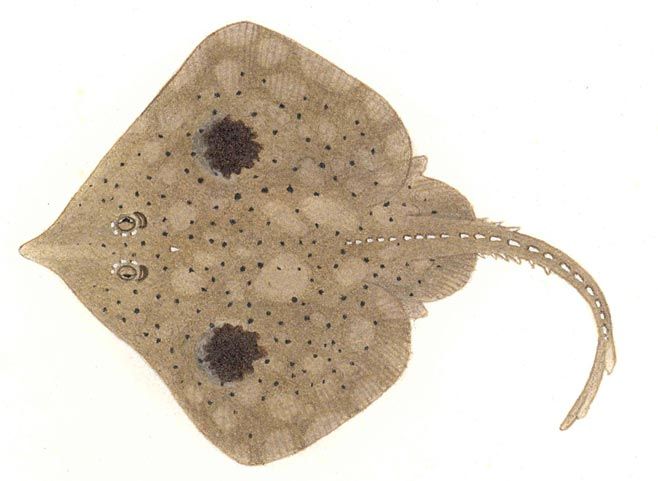|
Dipturus pullopunctata (Graybelly or slime
skate)
(Smith, 1964)
Life
> Eukaryotes >
Opisthokonta
> Metazoa (animals) >
Bilateria >
Deuterostomia > Chordata >
Craniata > Vertebrata (vertebrates) > Gnathostomata (jawed
vertebrates) > Chondrichthyes > Elasmobranchii > Batoidei >
Rajoidei > Rajidae
 |
|
Dipturus pullopunctata (Graybelly or slime
skate) [Illustration
by Ann Hecht ©] |
Identification
A strikingly two-toned longnosed skate, warm
brown above and abruptly dark grey below, with a conspicuous large
dark brown blotch on the upper base of each pectoral fin. Snout
moderately elongated and bluntly triangular, pectoral disk with
broadly rounded corners, and tail stout, not conspicuously swollen,
and about equal to body length. Thorns present at nape and along
midline of back and tail to first dorsal fin, nape spine enormous in
young; underside of disk not covered with small denticles.
Conspicuous wide-spaced black spots on upper disk of hatchlings and
juveniles, inconspicuous or lost on adolescents and adults, numerous
small white spots sometimes present in adults; undersurface with
numerous black-pigmented pores.
Size
To over 1.3 m TL and 94 cm DW.
Range
West and southeastern coast, Lu"deritz, Namibia, to Port
Alfred. Endemic.
Habitat
Found on soft substrates on the outer
shelf and upper slope on bottom at 50 to 457 m.
Biology
Common.
Feeds on bony fish, including jacopever, horsefish, beaked sandfish,
greeneyes, sandrat, lanternfish, gurnards, dragonets, and monkfish,
and crabs, shrimp, mysids, mantis shrimp, euphausiids, bivalves, and
cuttlefish. This skate is extremely slimy when captured, more so
than other local skates.
Human Impact
A common catch of hake
trawlers.
Text by Leonard J.V. Compagno, David A. Ebert
and Malcolm J. Smale
|
